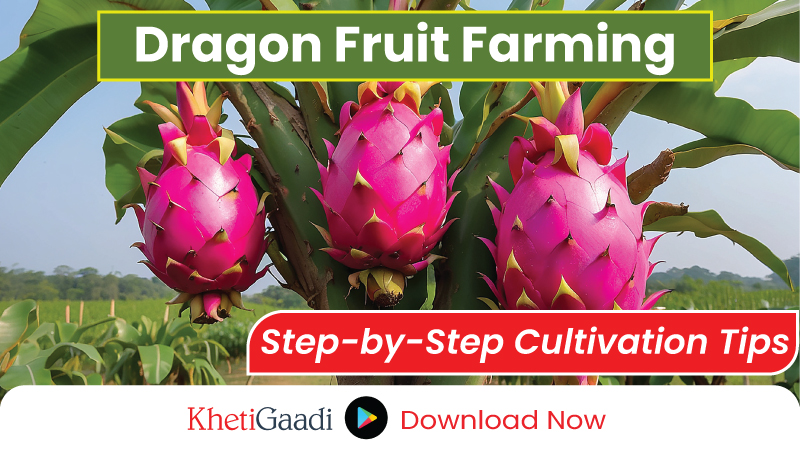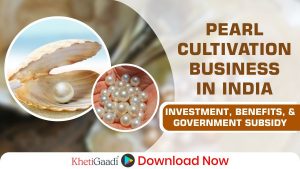Dragon fruit, also known as Pitaya, has recently gained popularity in India due to its unique appearance, taste, and health benefits. With growing demand in both domestic and international markets, dragon fruit farming has emerged as a profitable agricultural venture. This guide will walk you through everything you need to know about cultivating dragon fruit, from land and climate requirements to the cost and profit per acre, along with marketing ideas to maximize returns.
How to Cultivate Dragon Fruit?
Dragon fruit is a tropical and subtropical fruit that belongs to the cactus family. It is relatively easy to grow and requires less water compared to many other fruit crops, making it ideal for areas with water scarcity.
Steps for Cultivation
- Planting Season: The best time to plant this fruit is during the monsoon season (June to July). However, it can be planted year-round in tropical and subtropical regions.
- Planting Method:
- Dragon is generally grown from cuttings or seeds. Cuttings are preferred as they are faster-growing and start bearing fruit earlier than seed-grown plants.
- Plant the cuttings 1.5-2 meters apart in rows and provide vertical support structures for the climbing vines.
- Soil Requirements:
- It can grow in a wide variety of soils, but well-drained, sandy loam soil with a pH of 5.5-7 is ideal.
- Watering:
- As a cactus, these plants do not require much water. Overwatering can lead to root rot, so irrigation should be done sparingly.
- Fertilization:
- Organic compost and farmyard manure can be used as a base fertilizer. Balanced NPK (Nitrogen, Phosphorus, Potassium) fertilizers can be applied in small quantities to promote growth.
Land and Climate for Dragon Fruit Cultivation
Dragon fruit thrives in areas with tropical and subtropical climates. It is resilient to both heat and drought, making it a versatile crop that can be grown in several Indian states like Maharashtra, Karnataka, Gujarat, Andhra Pradesh, Tamil Nadu, and Telangana.
- Climate:
- It requires a temperature range of 20°C to 30°C.
- It is best grown in regions with low humidity and moderate rainfall (50-100 cm annually). Excessive rainfall or frost can damage the crop.
- Land:
- One acre of land can accommodate around 800-1,000 plants, depending on the spacing and support system.
- Land should be well-drained and exposed to adequate sunlight. Elevated lands with proper drainage are ideal to prevent waterlogging.
Dragon Fruit Harvesting
These fruit plants typically begin bearing fruit in the 2nd or 3rd year after planting. A well-maintained dragon fruit orchard can remain productive for up to 20 years.
- Flowering and Fruit Development:
- The plant begins flowering in May or June, and the fruit matures within 30-40 days after flowering. Fruits are usually harvested from July to November.
- Yield:
- In the initial years, a plant may yield 1-2 fruits per cycle. However, a mature plant can produce 4-6 cycles annually, with an average yield of 8-10 tons per acre.
- Harvesting Method:
- Dragon fruits are harvested when they turn bright red or yellow (depending on the variety). Overripe fruits can lose their taste, so timely harvesting is crucial.
Health Benefits of Dragon Fruit
Dragon fruit is often referred to as a “superfood” because of its numerous health benefits:
- Rich in Antioxidants: The fruit contains Vitamin C, beta-carotene, and betalains, which help fight free radicals and reduce oxidative stress.
- High in Fiber: It is an excellent source of dietary fibre, aiding digestion and helping regulate blood sugar levels.
- Boosts Immunity: The high Vitamin C content enhances the immune system and promotes skin health.
- Low-Calorie: Ideal for weight-conscious individuals, this fruit is low in calories and rich in essential vitamins and minerals.
- Heart Health: The seeds of this fruit are rich in omega-3 and omega-6 fatty acids, promoting heart health and reducing cholesterol levels.
Cost and Profit in 1 Acre Dragon Fruit Farming
The cost and profit from this farming can vary depending on several factors such as location, labour costs, and market conditions. Here’s a breakdown of the general expenses and potential profits:
Initial Investment Costs (1 acre)
- Land Preparation and Infrastructure: ₹30,000-₹50,000 (includes fencing, support structures, and irrigation systems).
- Planting Material (Cuttings): ₹20,000-₹30,000 (for 800-1,000 cuttings).
- Labor and Planting Costs: ₹20,000-₹25,000.
- Fertilizers and Manure: ₹10,000-₹15,000 annually.
- Irrigation: ₹5,000-₹10,000.
- Miscellaneous (Pesticides, Maintenance): ₹10,000 annually.
Total Initial Investment: ₹95,000-₹1,40,000
Annual Yield and Revenue:
- Yield: In the initial years, the yield is lower (3-4 tons per acre), but after the third year, the average yield can reach 8-10 tons per acre.
- Selling Price: The average market price for this fruit ranges from ₹150-₹200 per kg, depending on the season and quality.
Gross Revenue:
- At 8 tons/acre and a selling price of ₹150/kg, the revenue is ₹12,00,000 annually.
- Subtracting annual maintenance costs (~₹30,000-₹50,000), the net profit from 1 acre can be ₹10,00,000 or more after the third year.
Dragon fruit farming offers a lucrative return on investment once the plants reach maturity.
Marketing Ideas for Dragon Fruit
Effective marketing can greatly enhance the profitability of dragon fruit farming. Here are some ideas to explore:
A. Direct Sales to Consumers:
- Promote your dragon fruit as organically grown, pesticide-free produce, and sell directly to health-conscious consumers through farmers’ markets or online platforms.
B. Local Retailers and Supermarkets:
- Approach local grocery stores, supermarkets, and organic food outlets to stock your fruit. Offering bulk deals can attract regular buyers.
C. Partnership with Juice and Smoothie Bars:
- Given its “superfood” status, this fruit is in high demand at juice bars and health-focused cafes. Collaborating with these businesses can open a consistent supply chain.
D. Export Market:
- The international demand for this fruit is increasing. Exporting to neighboring countries or exploring the Middle Eastern and European markets can yield higher returns.
E. Value-Added Products:
- Consider producing and selling value-added products such as dried dragon fruit, dragon fruit powder, or even cosmetics like face masks made from the fruit.
F. Social Media and Branding:
- Build a brand for your farm and promote it on social media. Highlight the health benefits and unique farming practices, such as organic cultivation or eco-friendly methods, to attract urban consumers.
Conclusion
Dragon fruit farming in India is a profitable and sustainable agricultural practice. With an increasing demand for this superfood in both domestic and international markets, investing in cultivation can yield substantial returns. Proper planning, attention to climate and soil requirements, and adopting effective marketing strategies will ensure success in this venture.
By focusing on sustainable practices, cultivating high-quality produce, and tapping into niche markets, dragon fruit farmers in India have a bright and promising future.
Relevant Links:
- National Horticulture Board (NHB) – Dragon Fruit Cultivation Guidelines
- ICAR – Dragon Fruit Farming Techniques
- Dragon Fruit Farming Business Guide
- Government Schemes for Horticulture
- Export Potential of Dragon Fruit from India
Tags




